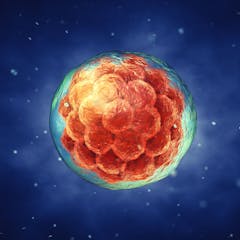
Articles on Stem cells
Displaying 1 - 20 of 83 articles

The technology may be here sooner than we think. But we have so much to discuss first.

Fifteen patients receiving an experimental stem cell therapy to treat advanced MS didn’t have the expected deteroriation in their condition.

Pigs with human kidneys? Brain-powered computer chips? Science is creating new kinds of living things – and our moral understanding needs to catch up fast.

Stem cells could help regenerate diseased or damaged parts of the body – but first, scientists need to make the cells forget their own histories.

Efforts to save one species can provide scientific knowledge that enables us to save other creatures in need.

Of the many qualities that make the zebrafish a model organism, the fact that it shares 70% of the genes humans have makes it an ideal candidate for developmental biology research.

In June, the possibility of synthetic embryos was announced at a conference. This allows some research to extend beyond the 14-day rule, which restricts experimentation on embryos beyond this period.

Zebrafish melanocytes cause diseases similar to those in people when they don’t work properly. Studying how they regenerate after injury could lead to new treatments for hair color loss and vitiligo.

These models could help us better understand infertility and early pregnancy loss.

We should think carefully about whether it is ethical to create living human-like beings only to conduct research on them.

Millions of people worldwide are exposed via soil and water to arsenic, whether naturally occurring or related to pollution. Chronic exposure is linked to the formation of cancer stem cells.

Many tumors have cancer stem cells that help them grow and evade treatments. Differentiation therapy forces these cells to mature, stopping growth with less toxicity than traditional treatments.

Growing cells we can use to produce blood is key to life-saving therapies after cancer treatment – this device has taken us a step closer.

Avoid while pregnant or trying to conceive: smoking, drinking, space travel.

In a huge milestone, researchers have grown a mouse embryo entirely from stem cells. Could humans be next?

While a strong immune response is essential to fight against viral infection, an immune system that continues to stay active long after the virus has been cleared can lead to lung damage.

Plus, how a new wave of South African romcoms is reimagining Johannesburg. Listen to episode 17 of The Conversation Weekly podcast.

The International Society for Stem Cell Research’s newly released guidelines aim to address new ethical challenges posed by stem cell advances such as model embryos and human-monkey hybrid embryos.

Researchers made human-monkey chimeras, by adding human stem cells to monkey embryos. Some embryos were cultured for 19 days after fertilisation.

Medical research to benefit people is first conducted in animals. Creating a new biomedical model by inserting human immune cells into pigs may lead to new insights and treatments.





